How I tried to promote regional robotics via the Internet
I am jokingly calling my mono-town in the Arctic Circle *. The mining plant occupies half the settlement area and makes everything look and feel like this:

There is no radio component store in Nikel. Nevertheless, having spent most of my life here, I even became a teacher of the robotics circle. Largely thanks to the Internet. So far my main achievement is an open master class for almost a hundred children, based on my own projects laid out in free access.
')
We have recently arranged such a thing for children in the city of Zapolyarny:
The video will prepare you for longrid.
No, this is not a “look at how cool I am” story.
Rather, it is a subjective chronicle of the problems and successes of robotics in the “small life forms”. It began when Geektimes has not yet become a source of inspiration and practical knowledge for people like us. And indeed, at that time there was little information about the assembly of robots at home in RuNet.
Probably, any story about “how we did something on the net” begins with this phrase. In the tenth grade, I got my first computer. Shel 2008th. We have been a year since going to the radio electronics circle.

Pentium 4 has already begun to be removed from production, but for our town, where even phones were a relative rarity, it was something.
On pre-computer days, my friends and I ran to the local library and looked for old magazines like Model Designer and Radio Amateur. Some interesting schemes sometimes flashed there. Thoroughly redrawing everything, we went in search of an old TV or a broken radio tape recorder in order to get the necessary details.
Due to the lack of components, part of the schemes remained on paper. But we said to ourselves: “Here we grow up, we will live in a big city, have everything we need at our fingertips and collect any robots!”

Modelka 1980 from the magazine "Model-Designer."
Naturally, getting access to the PC, I thought something like: "Now I will download ALL the drawings."
Being a novice, I was looking for how to assemble the simplest robots, and drove into the search about such queries: "How to make a robot with your own hands without a chip . " After all, one way or another, the microcircuit could be bought only in the store, and we did not have any stores. But it turned out that in the huge network that carried you far beyond the campus, there were almost no websites with articles on robotics for beginners.
And I thought: "Let me make my site and I will add information for people as unknown as I am." I created the site on July 27, 2009.
After school, I went to study in St. Petersburg, grabbing a soldering iron and diagrams. In the city, I immediately ran to the radio parts store, collected a huge box of everything, and in the evenings, while the guys from the hostel were walking, collecting robots.

"And just more, more cheese and more cutlets!" (C) "Bobby is visiting Barbosa"
Honestly, initially I wanted to be an architect. But, having a shortage of points in mathematics, I decided that let knowledgeable people study architecture better, and I will go to IT specialists. After all, the IT specialist has the right to make a mistake;)
So I entered the telecommunications college on the specialty "Computer software". We studied C programming, but most of the studies were connected to local networks, data transfer, etc. Of us raised sysadmins.
Then there was a lot of time to develop the site.
In short, I am a “programmer” and not a programmer as such. And as a student, I still had to solve a problem like "which platform will more or less allow not to pay." There was an option with Joomla, but hosting was needed there separately. Of course, I found cheap hosting, but I was afraid that with the load on the server they would tell me: “Pay more”.
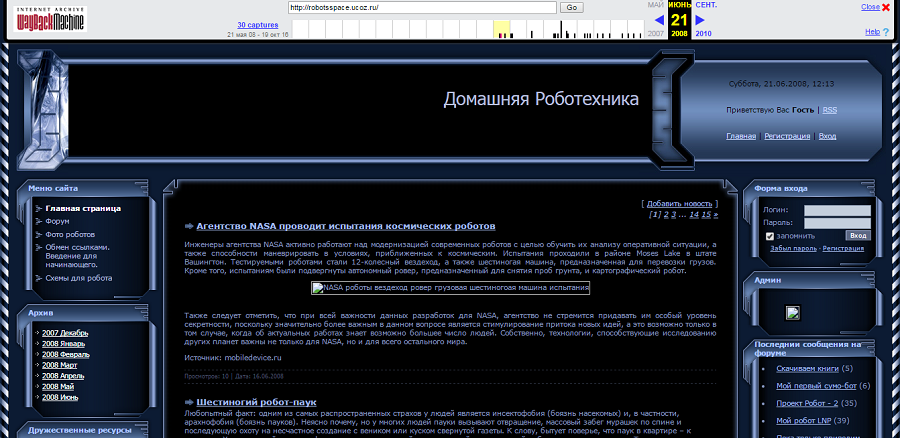
The screen takes us to the summer of 2008. Today, the project RobotsSpace abandoned.
Before starting my resource, I lived on strangers. My friends had a site RobotsSpace - also on robotics. The guys at one time had a very active forum, I was a frequent comment author, and later a moderator. I studied how their website worked (I liked it, in principle). He lived on a free domain from ucoz. So I heard about this system.
Having mastered it, I learned that you can climb in html-code, insert third-party scripts, download your templates. But the most important thing that I liked was that disk space increases automatically.
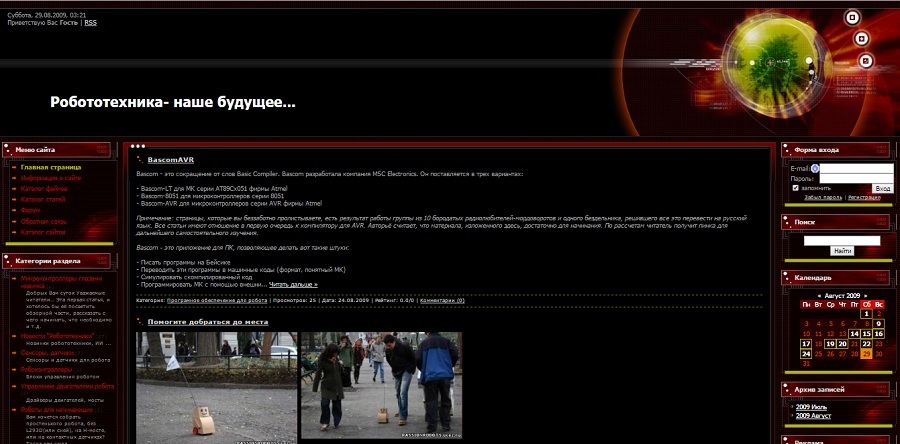
August 28, 2009, my site month. The then name - Rassionrobots - that is, with typos, reflects the then level of knowledge in a foreign language.
I was a student, and the free site suited me. Yes, there was an ad unit in the right corner, but then I turned it off as an educational project.
At first I copied other people's articles. Often the source was foreign sites, such as resources with the work of the “father” of BEAM-robotics Mark Tilden.

Example: beam-online.com contains very, very many interesting crafts with schemes and photographs.
In parallel, I tried to advertise on the forums of colleagues. We even had battles. There is such a site - Myrobot. We somehow quarreled with them: although I regularly published something useful in the topics and posted photos of my projects, the link to my site loomed in the signature - and this irritated the administration.
I had my own forum. At one time the activity on it was very large. I think I got at a time when there were not so many sites on robotics, and our resource was among the main ones. The user base eventually reached more than ten thousand addresses.

Example of instructions for beginners: a series of crafts "Planet Shelezyaka."
To develop the site further, I was looking for people who could write articles for beginners. Quietly, we started to invent our robots and describe them in detail: do step-by-step instructions with a photo, and then a video.

Later we renamed Servroid, bought a domain and redesigned it. The project turned out to be quite good: about thirty own articles, instructions, anyone can go in, choose by complexity, look at the lists of parts, buy components on the market, in a store or order by mail - and start acting!
The robots I collected in the evenings were not just a hobby for myself. They were made for competitions and some events where it was possible to demonstrate the project. Competition is an incentive to spend time with benefit.

The very spirit of the competition motivates even more: after all, geeks who bring something completely self-made, at events much less than the same people involved in Lego.
It is wildly cool when you put an improvised robot, and it competes with the “purchased”, say, legovsky one.
I remember my first competition in St. Petersburg. I came with a kind of "mastodon", in which a bunch of wires stuck out in different directions. He put it on the line, and he drove it somewhere in a minute. I drove very slowly, but very clearly.

The very first competitive robot.
Prior to that, everyone went through the line with the purchased ones, and I was the very last one - a beginner - putting my robot. You know, the silence is so, everyone is frozen. The people immediately appreciated.
Contests helped me draw attention to my online resource. I always said that you can assemble my robots yourself, this is an open project and, if you like it, you can explore everything on the site.
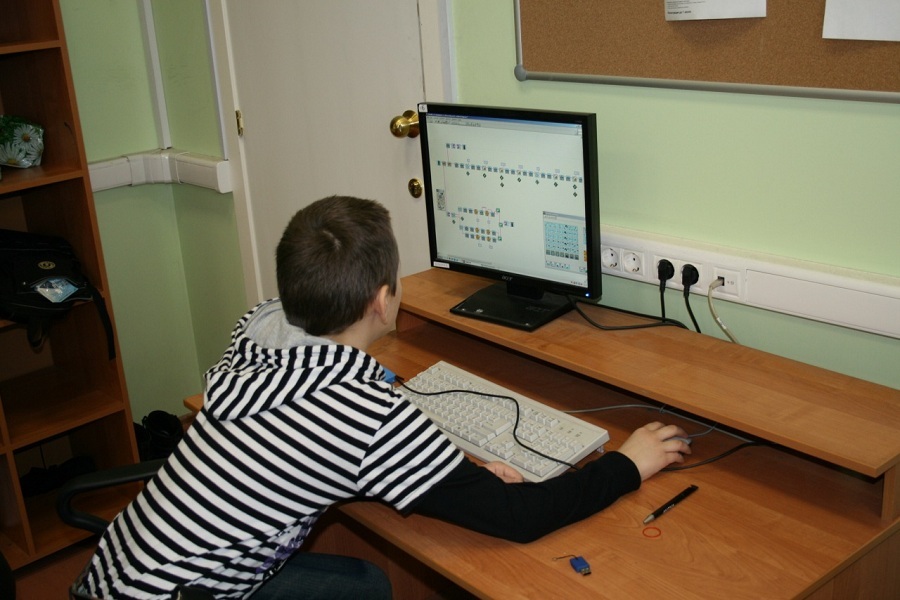
Thanks to the competition, I began to teach. It all started from the very first time: I was noticed by Sergey Aleksandrovich, the head of the robotics circle at the Physics and Mathematics Lyceum No. 239.
He was looking for student assistants, because students are active, everything is interesting for them. Therefore, they will motivate the children: “Let's put it together, let's participate somewhere, we will win someone!” Sergey Aleksandrovich suggested working with the children.
At first, I really refused. He doubted himself. Itself then in robotics was without a week. A year later, I came and said that I would be happy to help. So settled. Two or three times a week after couples ran to the lyceum. So I became a teacher of additional education without(sorry for the tautology) proper education.

We did cool projects with kids!
For example, there was a robot rover - a 3D copy of Curiosity. I drew sketches, and each child performed one detail on them. Then we assembled these parts, as a designer, only in a digital environment - “Compass”. And sent to the competition. When we were noticed in the Curiosity community, the project record gained about three hundred likes. We won the audience award.
The mater of robotics will seem nonsense, and this “socialization of robots” was very interesting for children.
Another project called "Cork-bot" - robots from traffic jams. The robot had vibromotors, as in cell phones, and the sensor is a light sensor that reacted to another similar robot.
We collected a whole flock of identical models, turned them on and got controlled chaos. Thanks to the LEDs that changed color (and, accordingly, the wavelength), the robots then began to gather in the crowd and the group went somewhere, then ran in different directions. And, in principle, with such projects we won the competition.
Two years as a teacher went great, but after graduating from college I had to go home. In parallel, I entered the school in Murmansk, and I had to jump on the program “Automation of technological processes of production”. And the development of hardware in the process control system is something like a lego-designer, only for adults.
In a small homeland again, problems began with the details. When I was completing another project, I photographed it, and then I unsoldered it for parts, so that there was something to assemble new robots.

To make a living, I became an IT specialist in the local administration.
As a student, I was able to follow the site for almost twenty-four hours a day. At work, I ran to the site only at lunchtime, and there was almost no time for online when there was a blockage. To continue doing this here, in the distance, a stimulus was needed.
Over time, I began to spend more time on VKontakte. He started a group, began to publish news and reviews on a deferred timer: uploaded a pack of descriptions at a time, and then they go out all day. What is good social network - so this free promo. For example, when the Kaspersky community wrote about us, about fifty new members immediately flew into the group.

So, own group becomes more and more readable. I hope thanks to her, someone also wants to assemble a robot or something else to do with their own hands.
In the “St. Petersburg period,” I sometimes went to hackspaces and even talked about my work for the Emergencies Ministry **. Visiting Murmansk, I found something like hackspace there. I wanted to repeat this with us.
And since in Nikel there is a wonderful factory next door, it’s also a town-forming enterprise, the management company is trying to somehow compensate the residents for their living conditions. There are annual grant programs for social projects: to build a house of creativity, to build a skating rink ... I thought that the idea of TsMITa, in principle, is appropriate.
I submitted an application: they say, let's launch a scientific workshop - 3D printers, laser machines, etc. He estimated the cost of equipment. What he did not immediately take into account was the repair of the premises: he demanded 7 million. It doubled the budget.
It looked like a room for the project (I apologize for the creaking of the microphone on the recording).
To show the seriousness of the intentions of the competition commission, I even managed to cut down the site:

After creating the site, I had 80-90% confidence that the project would pass. For a fab lab, a site is a very good place to attract.
I reached the final. The top five "chosen" of the 30 participants were taken to St. Petersburg. They showed me how the local fab lab works. However, it was not possible to rise to the cherished stage of financing. A piece for 14 million in the 15 thousandth town ... Yes, it probably sounds strange. But it was a rewarding experience.
Because then we won a grant to open a robotics circle .
Starting lego-robotics classes is not so difficult in principle even in the conventional “village”. You just need a sponsor who will allocate a budget for 5-10 sets. This is enough to open a circle.
In my childhood, the problem was that in the area no one really worked on robotics. And now I had the experience. Eight years after all. In St. Petersburg, I learned how to explain the basics of robotics to children, how to understand diagrams, how to work with 3D models, and so on.

So the insight came: when I communicate with someone on the topic of robotics, I will definitely leave links to the site with articles and to the public in order to demonstrate in every possible way that we are an active community.
And when people ask me what exactly I do, there’s nothing to refer to. Or rather, you can talk about it for hours, but ... it's a long time. There was no resource where people from companies could find out how to get profit from cooperation on the sponsorship model.

Somehow I went to the main uCoz and saw that there was now a form of choice: a personal website, a website for business and a store.
I became interested. What kind of website for business is this? After all, the search for sponsors is also a kind of enterprise. So I decided to click on this button.
Appeared in the new uKit designer. Everything is there on the finished blocks. For half a day I nakidal site portfolio. On uCoz, you still need to code, but here you clicked a button - the template was installed, and if you don’t like it, demolished one block, set another, threw text and photos - and the site is ready.
The portfolio is convenient to refer to when searching for sponsors. Well, you can change it quickly.
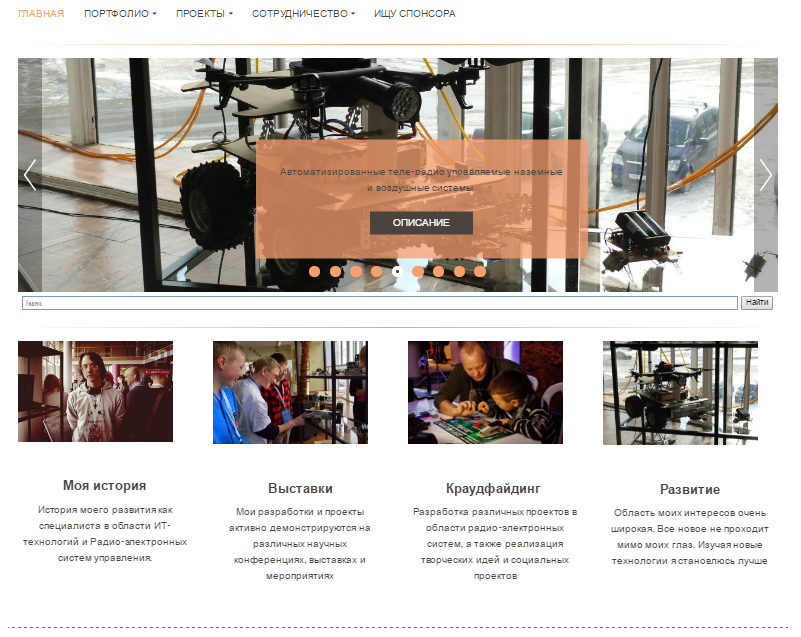
In general, having prepared on all fronts, we won the grant. From September 2016, I began to teach robotics for schoolchildren in my town. We collect simple robots. It took only 8 years to fulfill a childhood dream.

I have a circle in my own way: ideally, Legos should be 50% of the robot, and half of the project should consist of independently developed parts. This will allow the guys to broaden their horizons and work with their head, going beyond the constraints of the designer .
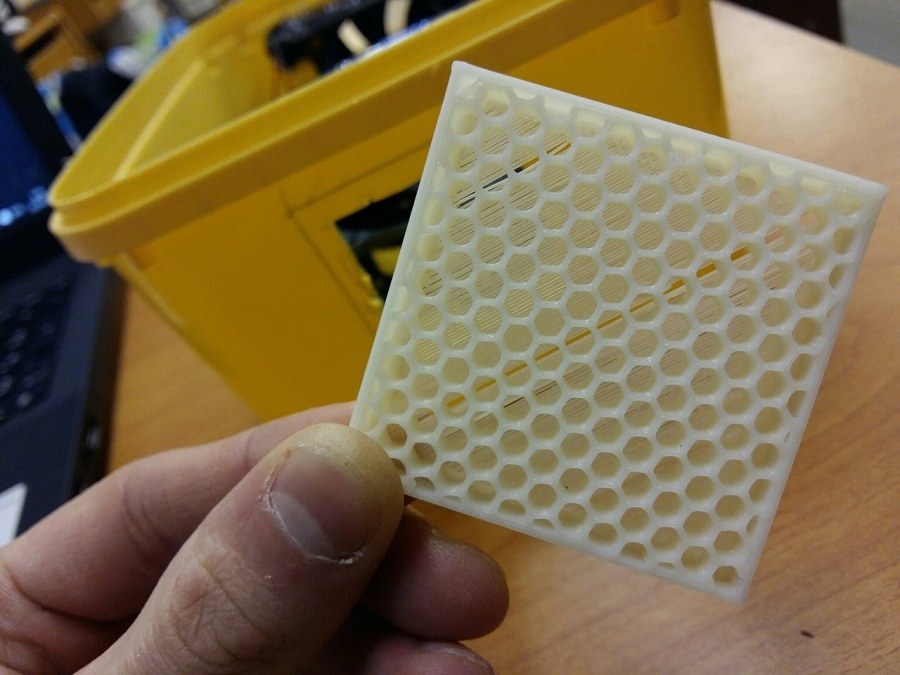
Grill filter for the project Lego-Robot Vacuum Cleaner printed by children from the robotics circle in Nikel.
***
Note from the authors of the blog: since then Sergey has become our active and “ideological” user. He writes video tutorials on the uKit system for beginners and regularly sends ideas on development. Since the fall, in order to earn some money for his projects, he also collects sites in our system for an order.
Notes from the author of the post:
* I am a fan of "Stalker", therefore I call my town Chernobyl
** Article about the work for the Ministry of Emergency Situations

There is no radio component store in Nikel. Nevertheless, having spent most of my life here, I even became a teacher of the robotics circle. Largely thanks to the Internet. So far my main achievement is an open master class for almost a hundred children, based on my own projects laid out in free access.
')
We have recently arranged such a thing for children in the city of Zapolyarny:
The video will prepare you for longrid.
No, this is not a “look at how cool I am” story.
Rather, it is a subjective chronicle of the problems and successes of robotics in the “small life forms”. It began when Geektimes has not yet become a source of inspiration and practical knowledge for people like us. And indeed, at that time there was little information about the assembly of robots at home in RuNet.
Go online. The first story - I connected the Internet
Probably, any story about “how we did something on the net” begins with this phrase. In the tenth grade, I got my first computer. Shel 2008th. We have been a year since going to the radio electronics circle.

Pentium 4 has already begun to be removed from production, but for our town, where even phones were a relative rarity, it was something.
On pre-computer days, my friends and I ran to the local library and looked for old magazines like Model Designer and Radio Amateur. Some interesting schemes sometimes flashed there. Thoroughly redrawing everything, we went in search of an old TV or a broken radio tape recorder in order to get the necessary details.
Due to the lack of components, part of the schemes remained on paper. But we said to ourselves: “Here we grow up, we will live in a big city, have everything we need at our fingertips and collect any robots!”

Modelka 1980 from the magazine "Model-Designer."
Naturally, getting access to the PC, I thought something like: "Now I will download ALL the drawings."
Being a novice, I was looking for how to assemble the simplest robots, and drove into the search about such queries: "How to make a robot with your own hands without a chip . " After all, one way or another, the microcircuit could be bought only in the store, and we did not have any stores. But it turned out that in the huge network that carried you far beyond the campus, there were almost no websites with articles on robotics for beginners.
And I thought: "Let me make my site and I will add information for people as unknown as I am." I created the site on July 27, 2009.
Going offline. Story One - “Big Cities”
After school, I went to study in St. Petersburg, grabbing a soldering iron and diagrams. In the city, I immediately ran to the radio parts store, collected a huge box of everything, and in the evenings, while the guys from the hostel were walking, collecting robots.

"And just more, more cheese and more cutlets!" (C) "Bobby is visiting Barbosa"
Honestly, initially I wanted to be an architect. But, having a shortage of points in mathematics, I decided that let knowledgeable people study architecture better, and I will go to IT specialists. After all, the IT specialist has the right to make a mistake;)
So I entered the telecommunications college on the specialty "Computer software". We studied C programming, but most of the studies were connected to local networks, data transfer, etc. Of us raised sysadmins.
Then there was a lot of time to develop the site.
Go online. The second story - when the forums were great
In short, I am a “programmer” and not a programmer as such. And as a student, I still had to solve a problem like "which platform will more or less allow not to pay." There was an option with Joomla, but hosting was needed there separately. Of course, I found cheap hosting, but I was afraid that with the load on the server they would tell me: “Pay more”.

The screen takes us to the summer of 2008. Today, the project RobotsSpace abandoned.
Before starting my resource, I lived on strangers. My friends had a site RobotsSpace - also on robotics. The guys at one time had a very active forum, I was a frequent comment author, and later a moderator. I studied how their website worked (I liked it, in principle). He lived on a free domain from ucoz. So I heard about this system.
Having mastered it, I learned that you can climb in html-code, insert third-party scripts, download your templates. But the most important thing that I liked was that disk space increases automatically.

August 28, 2009, my site month. The then name - Rassionrobots - that is, with typos, reflects the then level of knowledge in a foreign language.
I was a student, and the free site suited me. Yes, there was an ad unit in the right corner, but then I turned it off as an educational project.
At first I copied other people's articles. Often the source was foreign sites, such as resources with the work of the “father” of BEAM-robotics Mark Tilden.

Example: beam-online.com contains very, very many interesting crafts with schemes and photographs.
In parallel, I tried to advertise on the forums of colleagues. We even had battles. There is such a site - Myrobot. We somehow quarreled with them: although I regularly published something useful in the topics and posted photos of my projects, the link to my site loomed in the signature - and this irritated the administration.
I had my own forum. At one time the activity on it was very large. I think I got at a time when there were not so many sites on robotics, and our resource was among the main ones. The user base eventually reached more than ten thousand addresses.

Example of instructions for beginners: a series of crafts "Planet Shelezyaka."
To develop the site further, I was looking for people who could write articles for beginners. Quietly, we started to invent our robots and describe them in detail: do step-by-step instructions with a photo, and then a video.

Later we renamed Servroid, bought a domain and redesigned it. The project turned out to be quite good: about thirty own articles, instructions, anyone can go in, choose by complexity, look at the lists of parts, buy components on the market, in a store or order by mail - and start acting!
Going offline. Second story - motivation
The robots I collected in the evenings were not just a hobby for myself. They were made for competitions and some events where it was possible to demonstrate the project. Competition is an incentive to spend time with benefit.

The very spirit of the competition motivates even more: after all, geeks who bring something completely self-made, at events much less than the same people involved in Lego.
It is wildly cool when you put an improvised robot, and it competes with the “purchased”, say, legovsky one.
I remember my first competition in St. Petersburg. I came with a kind of "mastodon", in which a bunch of wires stuck out in different directions. He put it on the line, and he drove it somewhere in a minute. I drove very slowly, but very clearly.

The very first competitive robot.
Prior to that, everyone went through the line with the purchased ones, and I was the very last one - a beginner - putting my robot. You know, the silence is so, everyone is frozen. The people immediately appreciated.
Contests helped me draw attention to my online resource. I always said that you can assemble my robots yourself, this is an open project and, if you like it, you can explore everything on the site.

Thanks to the competition, I began to teach. It all started from the very first time: I was noticed by Sergey Aleksandrovich, the head of the robotics circle at the Physics and Mathematics Lyceum No. 239.
He was looking for student assistants, because students are active, everything is interesting for them. Therefore, they will motivate the children: “Let's put it together, let's participate somewhere, we will win someone!” Sergey Aleksandrovich suggested working with the children.
At first, I really refused. He doubted himself. Itself then in robotics was without a week. A year later, I came and said that I would be happy to help. So settled. Two or three times a week after couples ran to the lyceum. So I became a teacher of additional education without

We did cool projects with kids!
For example, there was a robot rover - a 3D copy of Curiosity. I drew sketches, and each child performed one detail on them. Then we assembled these parts, as a designer, only in a digital environment - “Compass”. And sent to the competition. When we were noticed in the Curiosity community, the project record gained about three hundred likes. We won the audience award.
The mater of robotics will seem nonsense, and this “socialization of robots” was very interesting for children.
Another project called "Cork-bot" - robots from traffic jams. The robot had vibromotors, as in cell phones, and the sensor is a light sensor that reacted to another similar robot.
We collected a whole flock of identical models, turned them on and got controlled chaos. Thanks to the LEDs that changed color (and, accordingly, the wavelength), the robots then began to gather in the crowd and the group went somewhere, then ran in different directions. And, in principle, with such projects we won the competition.
Exit online. The third story - the return to the small home
Two years as a teacher went great, but after graduating from college I had to go home. In parallel, I entered the school in Murmansk, and I had to jump on the program “Automation of technological processes of production”. And the development of hardware in the process control system is something like a lego-designer, only for adults.
In a small homeland again, problems began with the details. When I was completing another project, I photographed it, and then I unsoldered it for parts, so that there was something to assemble new robots.

To make a living, I became an IT specialist in the local administration.
As a student, I was able to follow the site for almost twenty-four hours a day. At work, I ran to the site only at lunchtime, and there was almost no time for online when there was a blockage. To continue doing this here, in the distance, a stimulus was needed.
Over time, I began to spend more time on VKontakte. He started a group, began to publish news and reviews on a deferred timer: uploaded a pack of descriptions at a time, and then they go out all day. What is good social network - so this free promo. For example, when the Kaspersky community wrote about us, about fifty new members immediately flew into the group.

So, own group becomes more and more readable. I hope thanks to her, someone also wants to assemble a robot or something else to do with their own hands.
Going offline. Fourth story - the corporate sector, or how we launched the TsMIT
In the “St. Petersburg period,” I sometimes went to hackspaces and even talked about my work for the Emergencies Ministry **. Visiting Murmansk, I found something like hackspace there. I wanted to repeat this with us.
And since in Nikel there is a wonderful factory next door, it’s also a town-forming enterprise, the management company is trying to somehow compensate the residents for their living conditions. There are annual grant programs for social projects: to build a house of creativity, to build a skating rink ... I thought that the idea of TsMITa, in principle, is appropriate.
I submitted an application: they say, let's launch a scientific workshop - 3D printers, laser machines, etc. He estimated the cost of equipment. What he did not immediately take into account was the repair of the premises: he demanded 7 million. It doubled the budget.
It looked like a room for the project (I apologize for the creaking of the microphone on the recording).
To show the seriousness of the intentions of the competition commission, I even managed to cut down the site:

After creating the site, I had 80-90% confidence that the project would pass. For a fab lab, a site is a very good place to attract.
I reached the final. The top five "chosen" of the 30 participants were taken to St. Petersburg. They showed me how the local fab lab works. However, it was not possible to rise to the cherished stage of financing. A piece for 14 million in the 15 thousandth town ... Yes, it probably sounds strange. But it was a rewarding experience.
Because then we won a grant to open a robotics circle .
Go online. The fourth and last story - how we launched the robotics circle in a small town
Starting lego-robotics classes is not so difficult in principle even in the conventional “village”. You just need a sponsor who will allocate a budget for 5-10 sets. This is enough to open a circle.
In my childhood, the problem was that in the area no one really worked on robotics. And now I had the experience. Eight years after all. In St. Petersburg, I learned how to explain the basics of robotics to children, how to understand diagrams, how to work with 3D models, and so on.

So the insight came: when I communicate with someone on the topic of robotics, I will definitely leave links to the site with articles and to the public in order to demonstrate in every possible way that we are an active community.
And when people ask me what exactly I do, there’s nothing to refer to. Or rather, you can talk about it for hours, but ... it's a long time. There was no resource where people from companies could find out how to get profit from cooperation on the sponsorship model.

Somehow I went to the main uCoz and saw that there was now a form of choice: a personal website, a website for business and a store.
I became interested. What kind of website for business is this? After all, the search for sponsors is also a kind of enterprise. So I decided to click on this button.
Appeared in the new uKit designer. Everything is there on the finished blocks. For half a day I nakidal site portfolio. On uCoz, you still need to code, but here you clicked a button - the template was installed, and if you don’t like it, demolished one block, set another, threw text and photos - and the site is ready.
The portfolio is convenient to refer to when searching for sponsors. Well, you can change it quickly.

In general, having prepared on all fronts, we won the grant. From September 2016, I began to teach robotics for schoolchildren in my town. We collect simple robots. It took only 8 years to fulfill a childhood dream.

I have a circle in my own way: ideally, Legos should be 50% of the robot, and half of the project should consist of independently developed parts. This will allow the guys to broaden their horizons and work with their head, going beyond the constraints of the designer .

Grill filter for the project Lego-Robot Vacuum Cleaner printed by children from the robotics circle in Nikel.
***
Note from the authors of the blog: since then Sergey has become our active and “ideological” user. He writes video tutorials on the uKit system for beginners and regularly sends ideas on development. Since the fall, in order to earn some money for his projects, he also collects sites in our system for an order.
Notes from the author of the post:
* I am a fan of "Stalker", therefore I call my town Chernobyl
** Article about the work for the Ministry of Emergency Situations
Source: https://habr.com/ru/post/369905/
All Articles